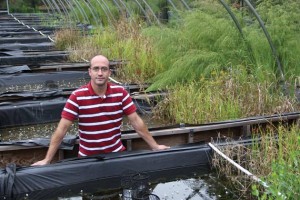Scientists have gone beyond laboratory based experiments and have used a mesocosm to accurately study the fate of single walled carbon nanotubes (SWNTs) in wetland ecosystems, showing that SWNTs accumulate and persist in aquatic sediments.

Lee Ferguson and his team constructed a wetland mesocosm to examine the fate of carbon nanotubes in the aquatic environment © Pratt School of Engineering at Duke University, US
Single walled carbon nanotubes are an intriguing class of nanoparticle, and their unique properties have led to their use in a wide variety of applications, ranging from microelectronics to energy storage and even drug delivery. However, the impact of SWNTs on the environment is not fully understood. As the use of SWNTs in industry increases, environmental contamination due to spills of SWNT-containing waste or weathering of SWNT-containing products becomes ever more likely, and so the importance of studies focusing on the fate of SWNTs in the environment is growing.
To read the full article, please visit Chemistry World.
Download the full article for free*:
Fate of single walled carbon nanotubes in wetland ecosystems
Ariette Schierz, Benjamin Espinasse, Mark R. Wiesner, Joseph H. Bisesi, Tara Sabo-Attwood and P. Lee Ferguson
DOI: 10.1039/C4EN00063C, Paper
* Access is free through a registered RSC account – click here to register










